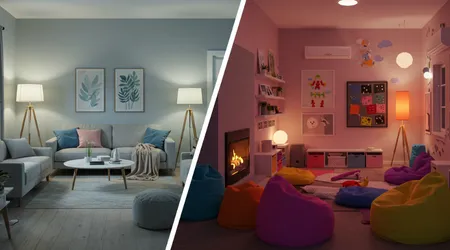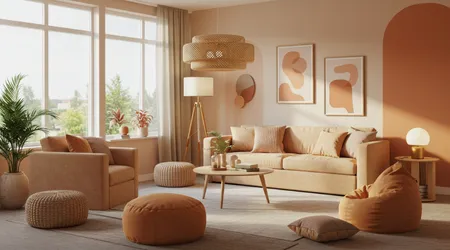How to Create a Sensory-Friendly Living Room

Create a sensory-friendly living room to foster a space where everyone feels at ease.
In 2025, as awareness of sensory sensitivities grows, designing inclusive home environments has become a priority for many.
Sensory-friendly spaces cater to individuals with autism, ADHD, or sensory processing disorders, but they benefit everyone by reducing stress and enhancing comfort.
This guide explores practical, research-backed strategies to transform your living room into a haven of tranquility, using thoughtful design, intentional choices, and modern tools.
Why settle for chaos when you can craft calm?
The living room is often the heart of a home, where families gather, relax, and connect. For those sensitive to sensory input, however, it can feel overwhelming.
Bright lights, loud sounds, or cluttered spaces can trigger discomfort or anxiety.
According to a 2023 study by the National Autistic Society, 90% of autistic individuals report sensory sensitivities impacting daily life.
Designing with these needs in mind isn’t just inclusive it’s transformative. This article dives into actionable steps, from lighting to textures, to create a sensory-friendly living room that balances aesthetics and function.
Understanding Sensory Sensitivities
Sensory sensitivities vary widely. Some people are hypersensitive, finding stimuli like bright lights overwhelming, while others are hyposensitive, craving more sensory input.
A sensory-friendly living room accommodates both, offering flexibility.
For instance, a hypersensitive person might need dim lighting, while a hyposensitive individual may enjoy tactile elements like soft cushions. Understanding these differences is the first step to intentional design.
Start by observing how people use the space. Does loud music from a TV cause distress? Are certain textures avoided? These insights guide your choices.
++ Accessibility in Grocery Stores: What Needs to Change
A living room should feel like a sanctuary, not a sensory minefield. Tailoring the environment to individual needs ensures everyone feels included and comfortable.
Flexibility is key. Incorporate adjustable elements like dimmable lights or movable furniture to adapt to varying sensory preferences.
This approach empowers users to customize their experience, making the space truly inclusive.

Lighting: Setting the Right Mood
Lighting shapes a room’s atmosphere. Harsh fluorescent bulbs can feel jarring, so opt for soft, adjustable lighting to create a sensory-friendly living room.
Use warm LED bulbs (2700K-3000K) for a cozy glow. Dimmable fixtures allow users to control brightness based on their needs.
Consider layered lighting. Combine ambient, task, and accent lights to offer versatility.
For example, a floor lamp with a dimmer can provide soft illumination for relaxation, while a task light aids reading. Avoid flickering bulbs, as they can trigger discomfort in sensitive individuals.
Read more: Top Mobility Aids for Small Spaces and Tight Budgets
Smart lighting systems, like Philips Hue, offer customizable colors and schedules. A 2024 review by TechRadar praised their ease of use for sensory-friendly homes.
Program lights to shift gradually, mimicking natural daylight, to reduce sensory overload.
Natural light is also vital. Use sheer curtains to diffuse sunlight, preventing glare.
Blackout shades can block excess light for those needing a darker environment. These options give users control over their sensory experience.
Sound: Crafting a Quiet Oasis
Noise can disrupt a sensory-friendly space. To create a sensory-friendly living room, prioritize sound control.
Rugs and curtains absorb echoes, softening the acoustic environment. Choose thick, plush rugs for maximum sound dampening.
Soundproofing panels, disguised as wall art, reduce external noise. Brands like Acoustimac offer stylish options in 2025.
Place them strategically near windows or shared walls. For example, a family in Seattle used acoustic panels to block street noise, transforming their living room.
White noise machines or calming soundscapes can mask disruptive sounds. Devices like the LectroFan EVO provide customizable noise options.
Alternatively, a small tabletop fountain adds soothing water sounds, enhancing relaxation without overwhelming.
Avoid placing TVs or speakers near seating areas. Instead, use wireless headphones for personal audio control.
This setup allows one person to enjoy media while others relax in quiet, balancing everyone’s needs.
Textures and Materials: Comfort Through Touch
Textures influence how a room feels physically and emotionally. To create a sensory-friendly living room, choose soft, natural materials like cotton or bamboo.
Avoid scratchy fabrics like rough wool, which can irritate sensitive skin.
Weighted blankets or cushions provide calming pressure for those craving tactile input.
For example, a parent in a 2024 Reddit thread shared how a weighted throw helped their autistic child relax. Offer a variety of textures smooth, fuzzy, or velvety for choice.
Furniture should feel inviting. Opt for rounded edges to prevent injury and overstimulation.
Modular sofas, like those from Burrow, allow rearrangement for comfort. Place tactile items, like fidget toys, within reach for added sensory support.
Cleanliness matters. Hypoallergenic fabrics reduce allergens, benefiting those with sensitivities.
Regularly wash throws and cushion covers to maintain a fresh, welcoming space. These small details enhance comfort significantly.
Color and Visual Calm: Less Is More
Colors impact mood. To create a sensory-friendly living room, use muted, neutral tones like soft blues or greens.
These hues promote calm, unlike bold reds that can overstimulate. A 2023 study in Frontiers in Psychology found blue tones reduce stress in 78% of participants.
Avoid busy patterns. Solid colors or subtle textures on walls and furniture prevent visual overload.
For instance, a family in Chicago painted their living room a soft sage green, noting improved relaxation. Keep decor minimal but personal.
Incorporate visual breaks. A plain wall or a single piece of art can soothe the eyes. Mirrors can make the space feel larger without adding clutter, but avoid reflective surfaces that cause glare.
If bold colors are desired, use them sparingly. A single vibrant cushion or rug can add personality without overwhelming. Balance is key to maintaining a calming visual environment.
Furniture Arrangement: Space and Flow
Cluttered spaces can feel chaotic. To create a sensory-friendly living room, arrange furniture for open flow.
Leave clear pathways to prevent sensory overload from tight spaces. Modular furniture offers flexibility for different needs.
Designate zones for specific activities, like a reading nook or a play area.
For example, a corner with a beanbag and books can be a quiet retreat. Ensure furniture is sturdy to avoid tipping, providing safety for all.
Keep surfaces clear. Too many objects can distract or overwhelm. Use storage solutions like ottomans with hidden compartments to tuck away items. This maintains a tidy, calming environment without sacrificing functionality.
Consider sensory tools like rocking chairs or swings. These provide gentle movement for those seeking sensory input.
A 2025 review by Sensory Integration magazine highlighted rocking chairs as a top choice for calming spaces.
Technology and Sensory Tools: Modern Solutions
Technology can enhance sensory-friendly design. Smart home devices, like voice-controlled thermostats, allow easy environmental adjustments.
To create a sensory-friendly living room, integrate tools that reduce sensory triggers.
Smart blinds, such as Lutron Serena, adjust light levels via an app, offering control without physical effort.
Pair them with motion-sensor lights for hands-free operation, ideal for those with motor challenges.
Sensory tools like fidget spinners or liquid timers can be discreetly placed on tables.
For instance, a teacher in Texas used a liquid timer to help her son focus during family movie nights. These tools provide calming distractions.
Limit screen glare. Use anti-glare TV screens or position devices to avoid reflections.
Offer noise-canceling headphones for personalized sound control, ensuring the space remains adaptable to individual needs.
Personalization: Making It Theirs

A sensory-friendly living room should reflect its users. Allow personalization to create a sensory-friendly living room that feels safe.
Let individuals choose a favorite cushion or artwork to foster ownership.
Involve family members in design decisions. A child might pick a soft throw, while an adult selects a calming scent diffuser. This inclusion builds emotional connection to the space.
Offer sensory stations. A basket with headphones, sunglasses, or stress balls lets users self-regulate.
For example, a New York family created a “calm corner” with these items, reducing meltdowns.
Respect boundaries. Some may prefer minimal decor, while others want vibrant touches. Regularly check in to ensure the space meets evolving needs, maintaining its role as a sanctuary.
Practical Examples and Tips
Imagine a living room where a soft blue rug muffles footsteps, dimmable lamps cast a gentle glow, and a weighted blanket rests on a plush sofa.
This setup, inspired by a 2025 HGTV feature, helped a family in Florida reduce sensory overload.
Another example: a minimalist living room with a rocking chair and noise-canceling headphones, praised in a 2024 blog for calming an ADHD teen.
Think of your living room as a symphony every element plays a role, but harmony comes from balance. Avoid overloading with stimuli.
Test changes gradually, like adding one new texture at a time, to gauge reactions.
| Element | Sensory-Friendly Choice | Benefit |
|---|---|---|
| Lighting | Dimmable LED (2700K) | Reduces glare, customizable |
| Sound | Acoustic panels, white noise | Minimizes echoes, masks noise |
| Texture | Cotton throws, weighted blankets | Soothes touch sensitivities |
| Color | Muted blues, greens | Promotes calm, reduces stress |
| Furniture | Modular sofas, rounded edges | Enhances safety, flexibility |
Conclusion: A Space for All
To create a sensory-friendly living room is to craft a space where everyone thrives.
By blending thoughtful design, modern technology, and personal touches, you build a sanctuary that soothes and uplifts.
In 2025, with sensory needs gaining recognition, such spaces are more vital than ever. Start small swap a bulb, add a rug, or involve loved ones in choices.
Each step brings you closer to a home that embraces all. What’s stopping you from creating your calm today?
Frequently Asked Questions
What makes a living room sensory-friendly?
It prioritizes low sensory input with soft lighting, muted colors, and sound control, tailored to individual needs for comfort and calm.
How can I afford sensory-friendly upgrades?
Start with budget-friendly changes like dimmable LED bulbs or thrifted soft furnishings. Gradually add items like acoustic panels as finances allow.
Can sensory-friendly design benefit everyone?
Yes, calming colors, soft textures, and quiet spaces reduce stress for all, not just those with sensory sensitivities.
Where can I find sensory-friendly products?
Check retailers like IKEA for affordable textiles or Amazon for smart lighting. Specialty stores like Sensory Scout offer targeted tools.
